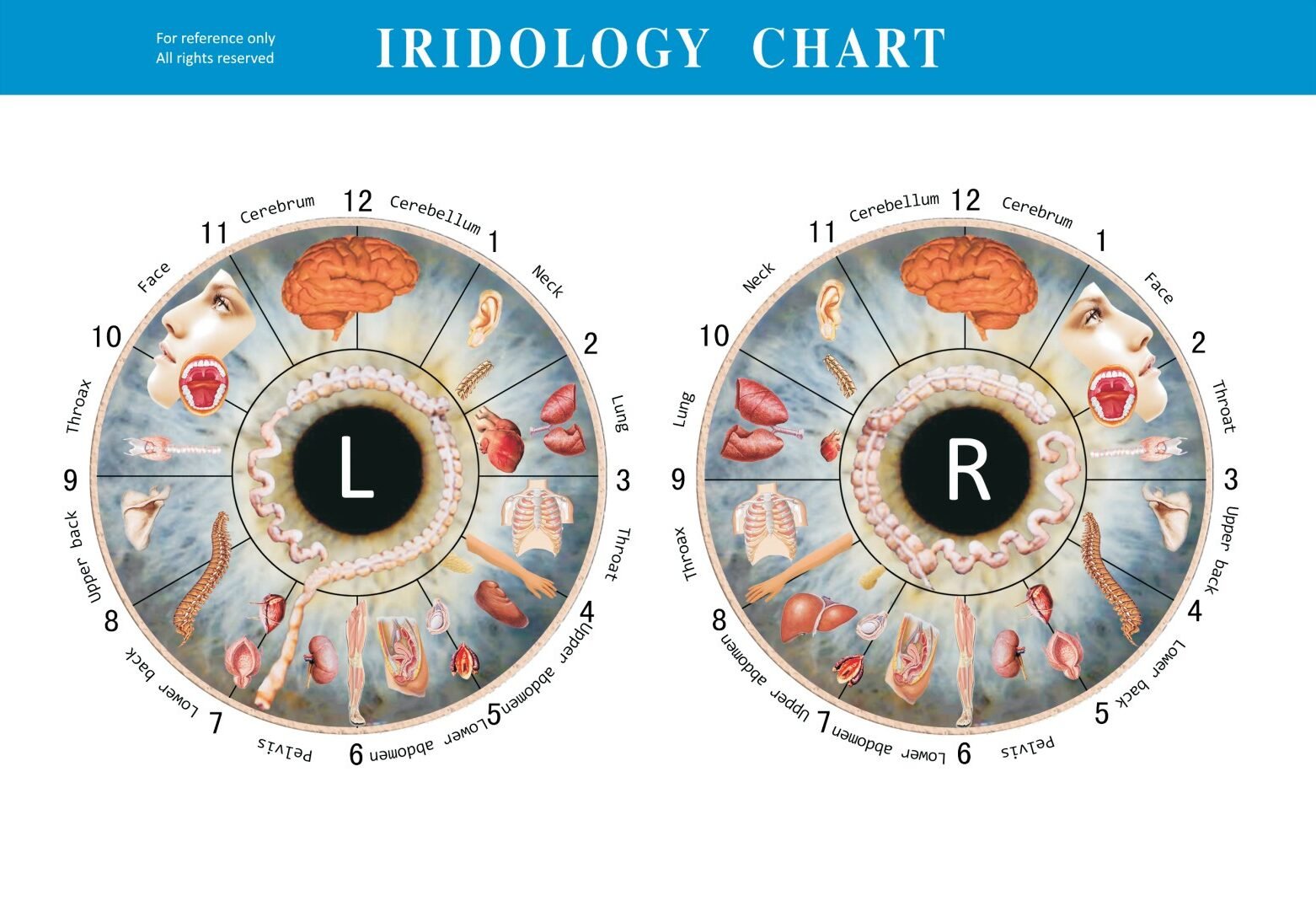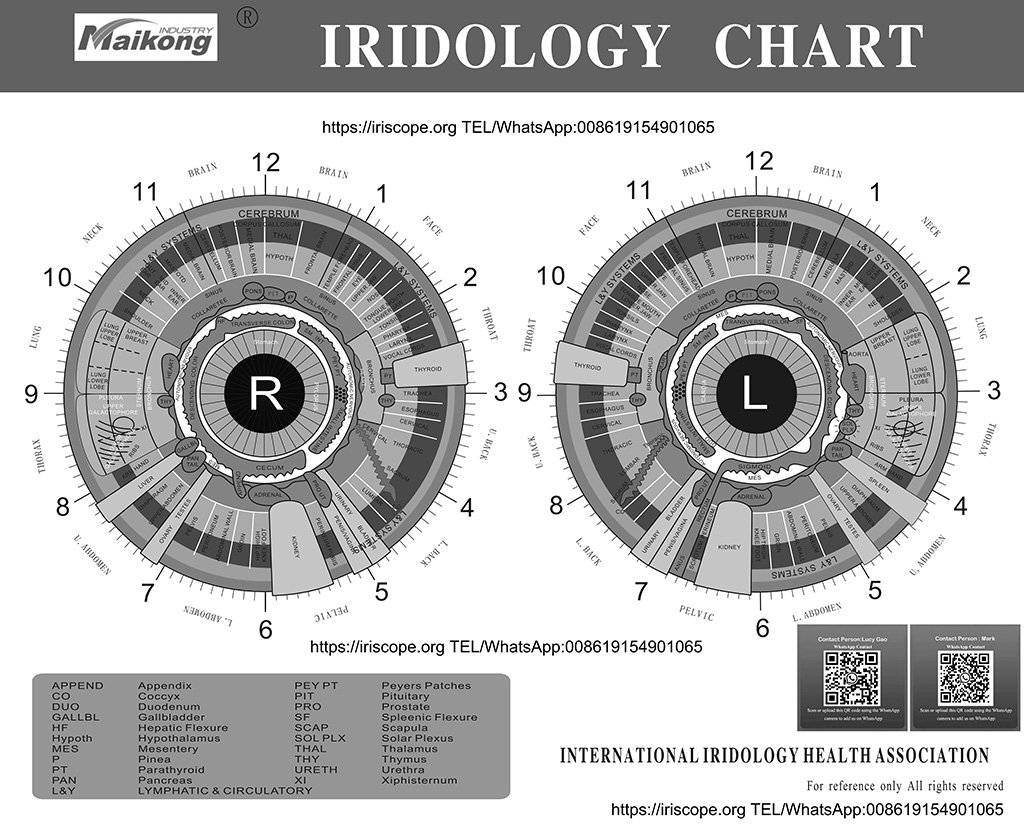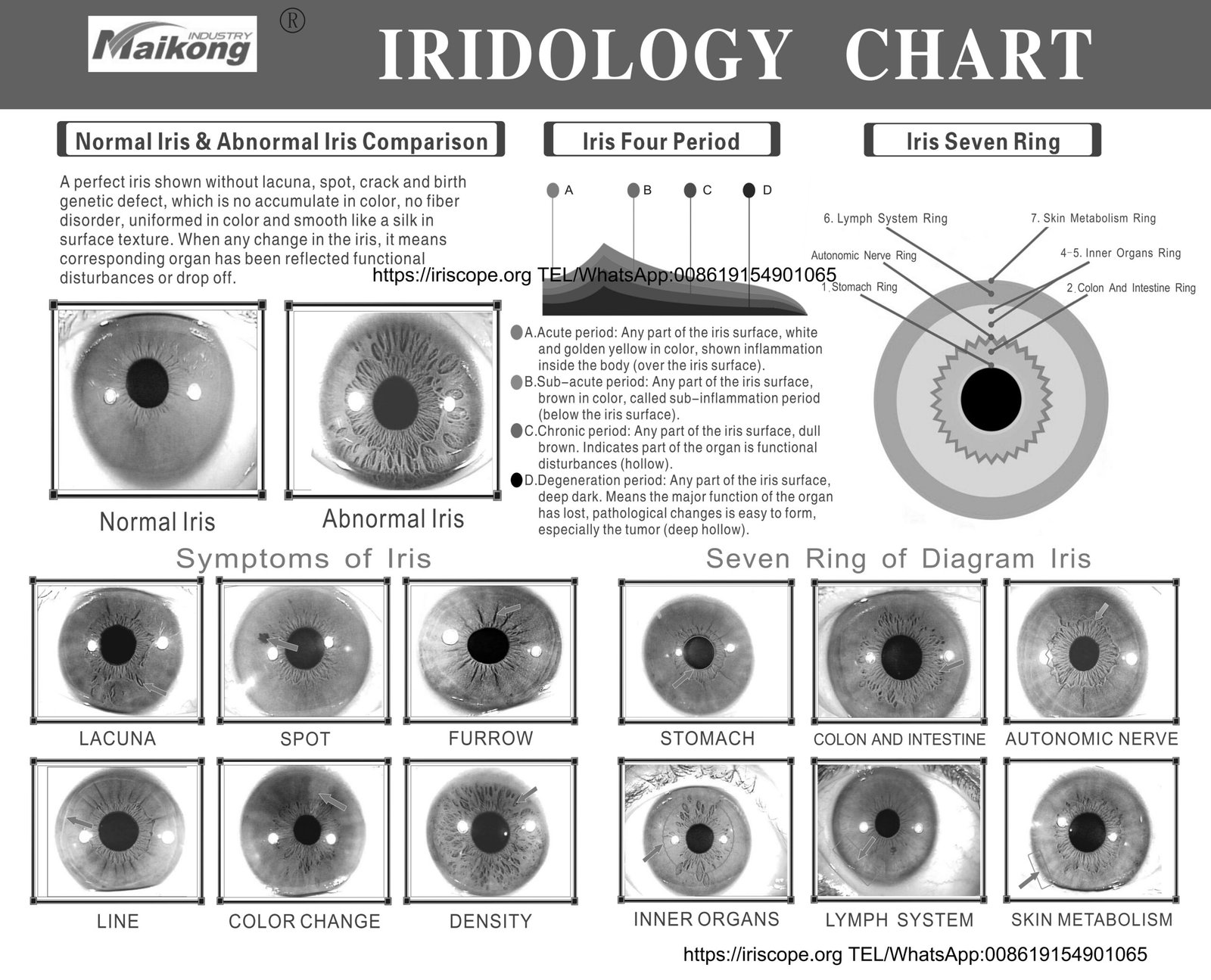ال left iris contains a wealth of information about your body’s health and constitution when properly analyzed using standardized مخطط القزحية systems. While many practitioners rely on iridology for holistic health assessment, the different mapping systems can yield varying interpretations. This comprehensive guide compares the three most respected left iris analysis frameworks—IIPA, Jensen, and Rayid models—to help you understand their unique approaches to the Iridology Chart and determine which system best suits your analytical needs.
Introduction to Iridology Chart and Its Importance


Standard Iridology Chart showing mapped zones of the left iris with corresponding body systems
An Iridology Chart serves as the fundamental reference tool for practitioners analyzing the colored part of the eye. These specialized maps divide the iris into zones that correspond to different organs and systems throughout the body. By examining the patterns, colors, and markings in specific areas of the iris, trained iridologists can identify potential health imbalances and constitutional strengths.
The left iris specifically relates to the left side of the body and provides insights into particular organ systems. Understanding the differences between major Iridology Chart systems is crucial for accurate analysis and interpretation of these iris signs.
Key Insight: The left iris is traditionally associated with the left side of the body, including organs like the heart, spleen, and left kidney. Different chart systems may place varying emphasis on certain zones or interpret markings differently.
Overview of Left Iris Analysis Frameworks
Before diving into the specifics of each model, it’s important to understand that these three frameworks represent different schools of thought in iridology. Each has developed its own approach to mapping and interpreting the Iridology Chart.
| Framework |
Origin |
Primary Focus |
Chart Complexity |
Best For |
| IIPA Model |
رابطة ممارسي القزحية الدولية |
Physiological systems |
High (detailed zones) |
Clinical practitioners |
| Jensen Model |
الدكتور برنارد جنسن |
Organ-specific analysis |
Medium (clear organ mapping) |
Holistic health assessment |
| Rayid Model |
Denny Ray Johnson |
Psychological/emotional patterns |
Low (personality-focused) |
Emotional/psychological analysis |
Each of these frameworks offers unique insights when analyzing the left iris. The choice of which Iridology Chart to use often depends on the practitioner’s training, the specific health concerns being addressed, and the desired depth of analysis.
IIPA Model: Methodology & Iridology Chart Applications
The International Iridology Practitioners Association (IIPA) has developed one of the most comprehensive approaches to the Iridology Chart. This system emphasizes physiological correlations and uses a highly detailed mapping system.
Key Features of the IIPA Iridology Chart
- Divides the iris into 7 concentric zones from the pupil to the outer iris
- Further segments the iris into approximately 60-degree sections corresponding to body systems
- Incorporates both topographical and functional relationships
- Distinguishes between acute, subacute, chronic, and degenerative tissue states
- Includes detailed nerve wreath analysis (autonomic nerve wreath)
The IIPA model is particularly valued for its systematic approach to iris analysis. It provides practitioners with a standardized framework that allows for consistent interpretation across different cases.
“The IIPA chart represents the culmination of decades of clinical observation and research, offering practitioners a detailed roadmap to physiological assessment through iris analysis.”
– رابطة ممارسي القزحية الدولية
For practitioners working with the left iris specifically, the IIPA model offers detailed mapping of zones related to the heart, spleen, stomach, pancreas, and left kidney—organs traditionally associated with the left side of the body.
Need Expert Guidance on IIPA Iridology Chart Analysis?
Our specialists can help you understand how the IIPA model applies to your specific health concerns through personalized iris analysis.
Jensen Model: Key Principles & Iridology Chart Integration
Dr. Bernard Jensen, often considered the father of modern iridology in North America, developed a widely-used Iridology Chart system that focuses on organ-specific correlations. His approach has become one of the most accessible and widely taught systems in the field.
Fundamental Elements of the Jensen Iridology Chart
- Uses a clock-face mapping system (1-12) for easy reference
- Divides the iris into seven concentric zones representing different tissue depths
- Emphasizes organ-to-zone correlations with specific health indicators
- Incorporates constitutional assessment through iris color and structure
- Includes detailed analysis of the collarette (autonomic nerve wreath)
The Jensen model is particularly noted for its practical clinical applications. In the left iris analysis, Jensen’s system provides detailed mapping for the heart zone (2-3 o’clock), spleen (1-2 o’clock), stomach (2-3 o’clock), and left kidney (6 o’clock).
Close-up of Jensen’s left iris heart zone mapping (2-3 o’clock position)
One of the strengths of Jensen’s approach is its integration of both structural and functional analysis. His Iridology Chart not only maps organ zones but also incorporates assessments of constitutional types based on iris color and structure.
Jensen’s Left Iris Constitutional Types
Blue Iris (Lymphatic)
Associated with sensitivity to lymphatic and respiratory systems. In the left iris, may indicate particular sensitivity in the heart and circulatory system.
Brown Iris (Hematogenic)
Associated with liver and blood-related tendencies. In the left iris, may indicate particular sensitivity in the spleen and digestive organs.
For practitioners analyzing the left iris, Jensen’s system provides a straightforward yet comprehensive framework that balances detail with practical application.
Rayid Model: Psychological Mapping via Iridology Chart
The Rayid Model, developed by Denny Ray Johnson, takes a distinctly different approach to the Iridology Chart by focusing primarily on psychological and emotional patterns rather than physiological correlations. This system has gained popularity among practitioners interested in the mind-body connection.
Core Components of the Rayid Iridology Chart
- Identifies four main personality types: Stream, Flower, Jewel, and Shaker
- Maps emotional patterns and psychological tendencies rather than physical organs
- Analyzes iris structures like fibers, crypts, and pigmentations for personality insights
- Incorporates left/right iris differences to understand emotional processing
- Focuses on mental-emotional constitution rather than physical health
In the Rayid system, the left iris specifically relates to the feminine, receptive, and emotional aspects of personality. It provides insights into how an individual processes emotions, relates to others, and responds to their environment.
The four Rayid personality types as shown in iris patterns
Left Iris Interpretation in the Rayid Model
| Rayid Type |
Left Iris Pattern |
Emotional/Psychological Correlation |
| Stream |
Straight fibers radiating from pupil |
Analytical, structured emotional processing, maternal relationships |
| Flower |
Rounded openings (crypts) in iris fiber |
Intuitive, feeling-oriented, nurturing tendencies |
| Jewel |
Concentrated pigment spots |
Focused emotional intensity, creative expression |
| Shaker |
Mixed patterns, often with zigzag fibers |
Adaptable, transformative emotional processing |
The Rayid model offers a unique perspective on the Iridology Chart by shifting focus from physical health to psychological patterns. For practitioners interested in emotional and mental aspects of health, this system provides valuable insights that complement physiological analysis.
Comparative Analysis: Strengths of Each Iridology Chart Model
Side-by-side comparison of IIPA, Jensen, and Rayid Iridology Chart models for left iris analysis
When choosing an Iridology Chart system for left iris analysis, understanding the comparative strengths of each model is essential. Each framework offers unique advantages depending on your analytical goals and clinical focus.
IIPA Model Strengths
- Highest level of anatomical detail and specificity
- Standardized approach with consistent terminology
- Strong emphasis on physiological correlations
- Comprehensive tissue layer analysis
- Well-documented research base
IIPA Model Limitations
- Steep learning curve due to complexity
- Requires significant training to apply effectively
- Less emphasis on psychological factors
- May be overly detailed for basic assessments
- Requires specialized equipment for optimal analysis
Jensen Model Strengths
- Intuitive clock-face mapping system
- Clear organ-to-zone correlations
- Balanced detail and practical application
- Extensive clinical documentation
- Accessible for practitioners at various levels
Jensen Model Limitations
- Less detailed than IIPA in some areas
- Some correlations based on older research
- Limited integration of newer findings
- Primarily focused on physical rather than emotional aspects
- Some zones have overlapping interpretations
Rayid Model Strengths
- Unique focus on psychological patterns
- Integrates emotional and mental aspects
- Simple personality type classification
- Complements physiological analysis
- Accessible conceptual framework
Rayid Model Limitations
- Limited physiological correlations
- Less scientific research validation
- Subjective interpretation elements
- Not focused on specific health conditions
- May oversimplify complex psychological factors
The optimal approach often involves integrating elements from multiple Iridology Chart systems to create a comprehensive analysis. Many experienced practitioners draw from all three frameworks, applying each where it offers the most valuable insights.
How to Choose the Right Iridology Chart Framework
Selecting the most appropriate Iridology Chart for your needs depends on several factors, including your specific health concerns, the depth of analysis required, and your practitioner’s expertise. Here’s a practical guide to help you determine which system might best serve your analytical goals:
Factors to Consider When Choosing an Iridology Chart System
Choose IIPA Model When:
- You need detailed physiological analysis
- Working with complex health conditions
- Seeking comprehensive tissue assessment
- Collaborating with medical professionals
- You have access to high-quality iris imaging
Choose Jensen Model When:
- Focusing on specific organ systems
- Needing a balanced analytical approach
- Working with nutritional correlations
- Seeking practical health applications
- You’re new to iridology analysis
Choose Rayid Model When:
- Exploring psychological patterns
- Addressing emotional components of health
- Complementing physical analysis
- Working on personality development
- Integrating mind-body approaches
نصيحة احترافية: Many experienced iridologists use a hybrid approach, applying different chart systems based on the specific aspect of health being analyzed. The left iris may be examined using the IIPA or Jensen model for physical health assessment, while the Rayid model might be applied to understand emotional patterns affecting those same systems.
For comprehensive analysis, consider working with a practitioner who is versed in multiple Iridology Chart systems. This integrated approach provides the most complete picture of both physical and emotional health factors.
Confused About Which Iridology Chart System Is Right For You?
Our experts can help you determine the most appropriate analytical framework for your specific health concerns and goals.
أرسل بريدًا إلكترونيًا إلى المتخصصين لدينا
Case Studies Using Iridology Chart Models
Before and after iris analysis showing changes following targeted interventions
To illustrate the practical applications of different Iridology Chart systems, let’s examine how each model might approach analysis of the same left iris in three different case scenarios.
Case Study 1: Cardiovascular Assessment
Client Profile:
54-year-old male with family history of heart disease, experiencing occasional chest discomfort and fatigue.
Left Iris Observation:
Dark lesion at 3 o’clock position in left iris with surrounding white fibers.
Analysis By Model:
- IIPA: Identified specific cardiac zone involvement with potential valve stress indicators
- Jensen: Noted heart zone congestion with autonomic nervous system involvement
- Rayid: Observed emotional stress patterns affecting heart function
In this case, the integration of all three Iridology Chart systems provided a comprehensive view of both the physical cardiac concerns and the emotional factors potentially contributing to the condition.
Case Study 2: Digestive System Analysis
Client Profile:
35-year-old female with chronic digestive complaints, bloating, and irregular bowel function.
Left Iris Observation:
Multiple crypts in stomach and intestinal zones (2-5 o’clock) with yellowish discoloration.
Analysis By Model:
- IIPA: Detailed mapping of specific digestive segments showing inflammation markers
- Jensen: Identified stomach and pancreatic stress with potential liver involvement
- Rayid: Noted Flower pattern indicating sensitivity to emotional stress affecting digestion
This case demonstrates how different Iridology Chart systems can complement each other to provide both specific physiological insights and understanding of constitutional tendencies.
Digital iris analysis software allowing integration of multiple chart systems
FAQs About Iridology Chart and Iris Analysis
How accurate are iridology charts for health assessment?
The accuracy of Iridology Chart analysis depends on several factors, including the practitioner’s skill, the quality of iris imaging, and the specific system used. While iridology is not considered a diagnostic tool in conventional medicine, many practitioners find it valuable for identifying constitutional tendencies and potential areas of weakness. It’s most effective when used as part of a comprehensive health assessment rather than as a standalone diagnostic method.
Can iridology charts detect specific diseases?
Iridology Chart analysis is not designed to diagnose specific diseases. Rather, it identifies tissue states, constitutional tendencies, and potential areas of weakness or stress in the body. Iridologists look for signs of inflammation, toxicity, or congestion that may indicate the need for further medical investigation. Always consult with qualified healthcare providers for diagnosis of specific conditions.
How do left and right iris analyses differ?
In traditional iridology, the left iris is associated with the left side of the body and typically relates to organs like the heart, spleen, and left kidney. The right iris corresponds to the right side, including the liver, gallbladder, and right kidney. Some systems also associate the left iris with feminine/receptive energy and the right with masculine/projective energy. A comprehensive analysis examines both irises to develop a complete picture.
What equipment is needed for accurate iridology chart analysis?
Professional iridology requires proper magnification and illumination. Basic tools include a penlight and magnifying glass (5-10x), while advanced practitioners use specialized iriscopes or digital iris cameras with 10-30x magnification. Software programs can overlay Iridology Chart templates on iris images for more precise analysis. The quality of equipment significantly impacts the detail and accuracy of observations.
How long does it take to learn iridology chart interpretation?
Becoming proficient in Iridology Chart interpretation typically requires 6-12 months of dedicated study for basic competency, and several years to develop advanced skills. Most practitioners start with one system (often Jensen’s) before expanding to others. Formal training programs range from weekend workshops to comprehensive certification courses spanning 100+ hours. Ongoing practice with experienced mentorship is essential for developing accurate analytical skills.
Conclusion: Integrating Iridology Chart Systems for Comprehensive Analysis
The study of Iridology Chart systems offers a fascinating window into holistic health assessment through iris analysis. While the IIPA, Jensen, and Rayid models each approach left iris mapping with different emphases and methodologies, they all contribute valuable perspectives to the practice of iridology.
For practitioners and those interested in iridology, understanding the strengths and applications of each system allows for a more nuanced and comprehensive approach to iris analysis. Rather than viewing these models as competing frameworks, consider them complementary tools that illuminate different aspects of health and constitution.
Whether your interest lies in detailed physiological assessment, practical organ-system correlations, or psychological insights, there is an Iridology Chart system that aligns with your analytical goals. Many experienced practitioners find that integrating elements from multiple systems provides the most complete picture of both physical and emotional health factors.
Experience Expert Iridology Analysis
Our specialists combine the best elements of IIPA, Jensen, and Rayid models to provide comprehensive iris analysis tailored to your specific health concerns.
✉️ Email: لوسي@iriscope.org



























